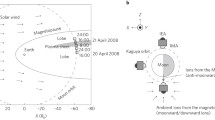Abstract
The isotopic composition and concentrations of helium are investigated in 9 samples taken from different depths of a soil column delivered by the Luna-24 mission. It is demonstrated that, with allowance made for random errors, the isotopic composition of helium remains invariable. The concentrations of helium are subject to considerable variations, the increases and decreases relative to the average value reaching a factor of 1.5–2. Assuming that the full length of the soil column was formed due to long-term accumulation of lunar clastic rocks (regolith), based on measurements of cosmogenic isotopes, a method of determining the rate of regolith accumulation has been developed, as well as a method of determining the age of the column soil samples. It is found that the rate of regolith accumulation is variable, and it changes over the column length within the limits (0.2–0.8 cm)/106 years. The range of the time for formation of the investigated part of the column is 100–600 million years. The observed decreases of concentration (at 250 and 600 million years) can be associated with both solar and lunar processes. In particular, a possibility of diffusion losses of helium due to the mechanism of jump-like diffusion is discussed, and diffusion parameters are found. A comparison of time periods of the observed variations in the solar wind with paleontological epochs and periods is made.
Similar content being viewed by others
References
Zadorozhnyi, I.K. and Ivanov, A.V., The Content and Isotopic Composition of Inertial Gases in Basic Samples of Luna-24 Regolith, in Lunnyi grunt iz Morya Krizisov (Lunar Soil from Mare Crisium), Moscow: Nauka, 1980, pp. 387–394.
Bogard, D.D. and Hirsh, W.C., Noble Gas Studies on Grain Site Separates of Apollo 15 and 16 Deep Drill Cores, Proc. 6th Lunar. Sci. Conf., 1975, vol. 2, pp. 2067–2083.
Vinogradov, F.P. and Zadorozhnyi, I.K., Inertial Gases in Regolith from Mare Fecunditatis, in Lunnyi grunt iz Morya Izobiliya (Lunar Soil from Mare Fecunditatis), Moscow: Nauka, 1974, pp. 379–386.
Anufriev, G.S., Boltenkov, B.S., Volkov, I.I., and Kapitonov, I.N., Growth Rate of Oceanic Ferromanganese Nodules Based on Helium and Neon Stable Isotopes, Litol. Polezn. Iskop., 1996, no. 1, pp. 3–11.
Alekseev, V.A., History of Ordinary Chondrites Traced by Data on Stable Isotopes of Inertial Gases, Astron. Vestn., 2004, vol. 38, no. 3, pp. 225–234.
Leya, I., Lange, H.-R., Heumann, S., et al., The Production of Cosmogenic Nuclides by Galactic Cosmic-Ray Particles for 2fy Exposure Geometries, Meteoritics and Planet. Sci., 2001, vol. 36, pp. 1547–1561.
Eberhardt, P., Geiss, J., Graf, H., et al., Trapped Solar Wind Noble Gases, Exposure Age and K/Ar-Age in Apollo 11 Lunar Fine Material, Proc. Apollo 11 Lunar Sci. Conf., Houston, 1970, vol. 2, pp. 1037–1070.
Rode, O.D, Ivanov, A.V., Tarasov, L.S., and Korina, M.I., General Lithologic and Morphologic Characteristic of the Luna-24 Regolith Column, Geokhimiya, 1977, no. 10, pp. 1465–1476.
Anufriev, G.S. and Galimov, E.M., Loss of Helium by Lunar Regolith, Dokl. Akad. Nauk, 2008, vol. 420, no. 6, pp. 805–807.
Anufriev, G.S., Boltenkov, B.S., Usacheva, L.V., and Kapitonov, I.N., Variations of Isotope Composition of According to Gases during Solar Flares (Rate Lunar Rock Samples), Izv. Akad. Nauk SSSR, Ser. Fiz., 1983, vol. 47, no. 9, pp. 1830–1837.
Morozova, I.M. and Ashkinadze, G.Sh., Migratsiya atomov redkikh gazov v mineralakh (Migration of Atoms of Rare Gases in Minerals), Moscow: Nauka, 1971.
Manning, J.R., Diffusion Kinetics for Atoms in Crystals, New York: Van Nostrand, 1968. Translated under the title Kinetika diffuzii atomov v kristallakh, Moscow: Mir, 1971.
Bard, E., Raisbeck, G.M., Yiou, F., and Jousel, J., Solar Modulation of Cosmogenic Nuclide Production over the Last Millennium: Comparison between 14C and 10Be Records, Earth Planet. Sci. Lett., 1997, vol. 150, nos. 34, pp. 453–462.
Kovalenko, V.A., Solnechnyi veter (Solar Wind), Moscow: Nauka, 1983.
Schwenn, R., Solar Wind Sources and Their Variation over the Solar Cycle, Space Sci. Rev., 2006, vol. 124, no. 1, pp. 51–76.
Galimov, E.M., The Project “Luna-Gelii-3”, Nauka v Rossii, 2006, no. 6, pp. 15–23.
Schmitt, H.H., Return to the Moon, New York: Copernicus Books, 2006, p. 335.
Author information
Authors and Affiliations
Corresponding author
Additional information
Original Russian Text © G.S. Anufriev, 2010, published in Kosmicheskie Issledovaniya, 2010, Vol. 48, No. 1, pp. 102–108.
Rights and permissions
About this article
Cite this article
Anufriev, G.S. Flux and isotopic composition of helium in the ancient solar wind. Cosmic Res 48, 101–107 (2010). https://doi.org/10.1134/S0010952510010089
Received:
Published:
Issue Date:
DOI: https://doi.org/10.1134/S0010952510010089



